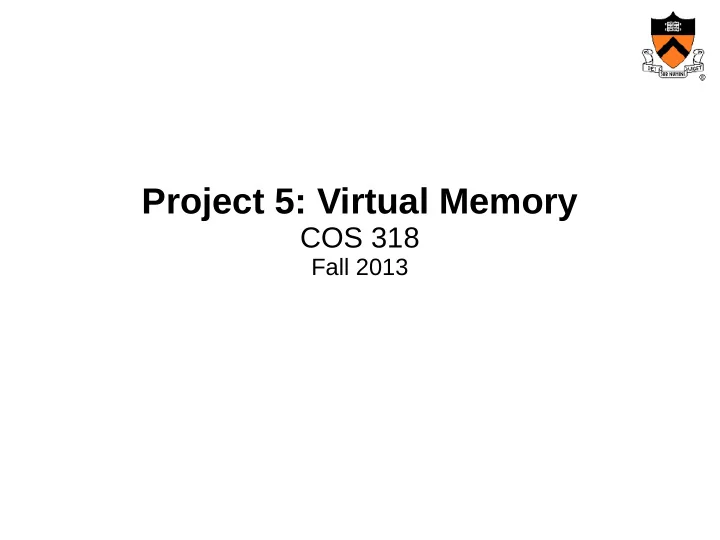

Project 5: Virtual Memory COS 318 Fall 2013
Project 5 Schedule ● Design Review – Monday, Nov 25 – 10-min time slots from 10am to 8pm ● Due date: Wed Dec 4, 11:55pm
General Suggestions ● Project is not divided into phases. ● Follow the rough checklist in the project 5 specs. ● Get familiar with the 2-level page table description of i386. ● Read section 3.7.1 and 4.2 of the Intel manual. ● Look at new PCB structure in kernel.h . ● As always, start as early as you can, and get as much done as possible by the design review.
Project 5 Overview ● Implement page allocation and eviction policy. ● Initialize the memory layout (kernel pages). ● Set up each process' memory. ● Swap pages in/out of disk → demand paging. ● Page fault handler. ● Relevant files: memory.h and memory.c ● No assembly programming ☺ ● Extra credit: Better eviction policy.
2-Level Page Table (i386) ● See section 3.7.1 in Intel Manual (p. 84-85)
Directory Entries ● See section 4.2 in Intel Manual (p. 106-107)
Table Entries ● See section 4.2 in Intel Manual (p. 106-107)
Entry Flags ● See section 4.2 in Intel Manual (p. 106-107) ● P: Page/Page table loaded? ● U/S: User access? 0 → no user access ● R/W: User read/write? 0 → user read-only ● A: Accessed? set on swap-in ● D: Dirty page? use at swap-out
Page Allocation and Eviction ● Define a page map data structure to track all pages and their metadata (in memory.h ). ● If there is a free page, simply use it. ● Otherwise, you need to swap a page out. ● Recall that you can pin pages → can't evict these pages! ● Simple eviction policy: e.g. FIFO
Initialize Kernel Memory ● Allocate N_KERNEL_PTS (page tables) ● For each page table, allocate pages until you reach MAX_PHYSICAL_MEMORY. ● Important: physical address = virtual address. ● Make sure to set correct flags! ● Give the user permission to use the screen.
Setting up Process Memory ● Processes keep track of 4 types of pages: – Page directory – Page tables – Stack page table – Stack pages ● PROCESS_START (vaddr of code + data) – Use one page table and allocate all pages. – Needs pcb->swap_size memory. ● PROCESS_STACK (vaddr of stack top) – Allocate N_PROCESS_STACK_PAGES.
Swapping pages in and out ● USB disk image for swap storage. ● Swap in for allocation, swap out for eviction. ● Assume that processes do not change size. ● Processes use whichever location they were originally loaded from (pcb->swap_loc). ● Use usb/scsi.h for read and write functions. ● Keep in mind: When do you need to flush the TLB?
Handling Page Faults ● Get a free page from the page allocator. ● Swap in the page. ● Update the page table entry to the page's address and set the present flag.
Some more tips... ● One page table is enough for a process' code and data memory space. ● Some functions (especially page fault handler) can be interrupted! – Use a synchronization primitive. ● Some pages don't need to be swapped out. – Kernel pages, process page directory, page tables, stack page tables and stack pages. – With respect to grading!
Recommend
More recommend